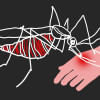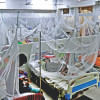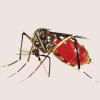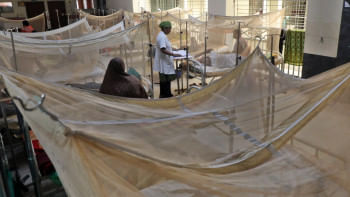Posh areas ideal place for Aedes
Upscale neighbourhoods in Banani, Bashundhara, Uttara, Dhanmondi, Mohakhali DOHS, and Mintoo Road are major breeding grounds of dengue and chikungunya spreading Aedes mosquitos, found a survey.
Stagnant clean water at construction sites and other open spaces in the areas provide the ideal breeding environment for Aedes, the survey conducted by the Centre for Communicable Diseases of the Directorate General of Health Services had found.
“The areas having a high presence of the Aedes mosquito are also in high risk of dengue or chikungunya,” said Professor Mahmudur Rahman, former director of Institute of Epidemiology, Disease Control and Research (IEDCR).
He added that the risk of a dengue outbreak was higher this year than that of chikungunya as many city residents might have become immune to chikungunya.
The DGHS recorded at least 13,814 chikungunya cases last year, the highest since 2008 when there were only 32 cases.
At least 2,766 persons were infected with dengue last year, a significant improvement from 6,060 in 2016.
The recent survey findings indicate high risks of the viral diseases not only in Dhaka, but also in the region.
According to the World Health Organisation (WHO), some 50-100 million cases of dengue were reported worldwide each year, and 75 percent of the cases were in the Asia-Pacific region.
The WHO said the cases were approximately 30 times more than that of 50 years ago.
Epidemiologists have recommended immediate and befitting measures to clean the mosquito breeding places.
THE SURVEY
The study surveyed 2,000 households on a total of 100 sites of 41 wards under Dhaka North City Corporation (DNCC) and 59 wards under Dhaka South City Corporation (DSCC) between January 11 and January 20.
It found high presence of aedes in at least 19 areas.
Moreover, at least 19 houses in every 100 had Aedes mosquito larvae or pupae.
At least 27 percent of the households in the DNCC and 14 percent in the DSCC were found to have stagnant water, mostly in containers of some sort, with mosquito larvae or pupae, according to the report.
MM Akhtaruzzaman, deputy programme manager of Epidemic Disease Control Department, said stagnant water in the open spaces was to blame.
“Sometimes cars are washed and water cannot be drained properly. In the posh areas, usually around high rise buildings, open spaces are mosquito breeding grounds. The concentration of mosquito is higher in areas with many tall buildings.”
The study also surveyed Gabtoli, Moghbazar, Malibagh, Mirpur 1, Nakhalpara, Purbo Sheorapara, Tolarbagh, Uttara 9, Banglabazar, Elephant Road, Gulbagh, Kalabagan, Meradia, and Shantinagar.
Aedes mosquitoes can hide in the shadows of trees, behind windows and doors, the survey said.
It found Aedes larvae or pupae in plastic barrels, buckets, clay pots, used or abandoned tires, tubes and water tanks.
Wet floors and puddles in construction sites are also ideal environments for mosquito breeding, Akhtaruzzaman said.
On the other hand, in neighbourhoods with scarcity of water, people often store water in tanks, increasing the risks, he said.
Public health expert Mahmudur Rahman suggested through cleaning of areas and the use of larvicide so that the larvae could not grow to adults.

 For all latest news, follow The Daily Star's Google News channel.
For all latest news, follow The Daily Star's Google News channel. 








Comments